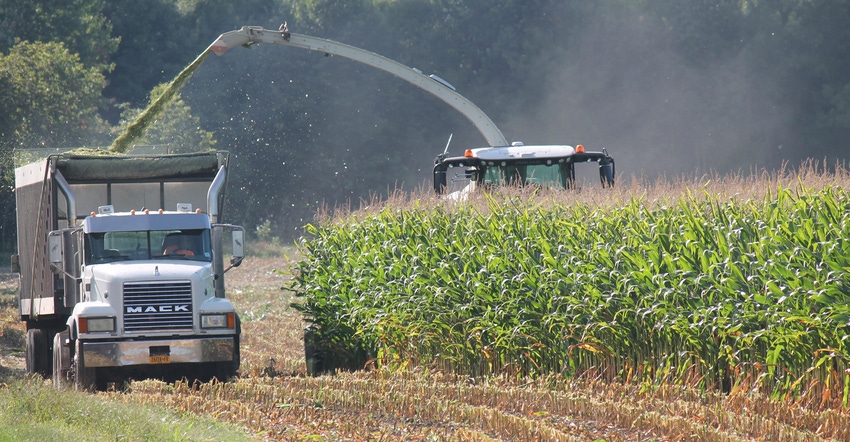
Still haven’t decided what corn silage to grow next season? Take a look at recent corn silage hybrid trials run by Penn State, and trials run jointly by the University of Vermont and Cornell last summer.
The New York and Vermont trials were done across four sites in New York and at Borderview Farm in Vermont. Hybrids were entered in the 80- to 95-day relative maturity group, or the 96- to 110-day RM group.
“We had 13 different brands of corn enter the 2022 program for a total of 67 hybrids,” says Joe Lawrence, dairy forage systems specialist at Cornell Pro-Dairy, adding that the early group included 26 entries and the late-maturity group featured 41 entries.
“There was not too much new this year,” he adds. “The past few years, we have been measuring nitrogen balances of the corn to better understand how efficient it is in using N. We don’t see much difference between hybrids, but we do see some interesting site-to-site differences that are discussed in the report.”
Short-season results
The Oakfield, N.Y., site averaged 21 tons per acre at 35% dry matter, ranging between 19.1 tons and 23.8 tons per acre. Starch averaged 36.7% with a range of 30.6% to 41.6%. Crude protein averaged 8.2%, ranging from 7.6% to 8.7%.
The Willsboro, N.Y., site averaged 25.9 tons per acre, ranging from 23.8 tons to 29.2 tons per acre. Starch averaged 37.2%, ranging from 33.8% to 40.3%. Crude protein averaged 8.5%, ranging from 8.0% to 9.1%.
The Vermont site averaged 27.8 tons, ranging from 24.1 tons to 30.7 tons per acre. Starch averaged 36.2%, ranging from 33.1% to 40.6%. Crude protein averaged 8.2%, ranging from 7.5% to 9.0%.
Late RM results
The long-season Vermont site averaged 27.3 tons per acre, ranging from 23.8 tons to 30.7 tons per acre. Starch averaged 38.7%, ranging from 32.7% to 42.1%. Crude protein averaged 8%, ranging from 6.9% to 8.6%.
The Madrid, N.Y., site averaged 31.1 tons, ranging from 28.1 tons to 34.4 tons per acre. Starch averaged 39.6%, ranging from 35.8% to 44.7%. Crude protein averaged 7.6%, ranging from 6.7% to 8.4%.
The site in Aurora, N.Y., averaged 20.7 tons, ranging from 18.8 tons to 23.7 tons per acre. Starch averaged 37.2%, ranging from 31.7 to 42.9%. Crude protein averaged 7.8%, ranging from 7.1% to 8.7%.
Pennsylvania results
Penn State’s trial evaluated corn silage varieties submitted by dozens of companies, and split the results based on short-season, midseason and late-season groups.
The short-season trial evaluated 26 varieties from 10 different seed companies on farms in Bradford, Centre and Clinton counties. The midseason trial evaluated 11 varieties from seven seed companies in Lancaster and Juniata counties, and 25 varieties from 10 seed companies in Blair, Centre and Huntington counties.
The late-season trial in Chester, Juniata and Lancaster counties evaluated 34 varieties from 13 different seed companies.
The short-season average yield was 17.3 tons per acre, ranging from 14.1 to 19.3 tons per acre. Crude protein averaged 8%, ranging 7.3% to 8.9%. Starch as a percentage of DM averaged 40.5%, ranging from 36.6% to 44.3%.
The midseason trial in Blair, Centre and Huntington counties averaged 19.5 tons per acre, ranging from 18.0 to 21.2 tons per acre. Crude protein averaged 8.3%, ranging from 7.7% to 8.8%. Starch averaged 41.2%, ranging from 38.1% to 43.7%.
The midseason trial in Lancaster and Juniata counties averaged 17.6 tons, ranging from 16.9 to 18.6 tons per acre. Crude protein averaged 8%, ranging from 7.5% to 8.4%. Starch averaged 40.5%, ranging from 36.9% to 43.3%.
The late-season trial averaged 21.5 tons, ranging from 18.5 tons to 22.9 tons per acre. Crude protein averaged 8.2%, ranging from 7.5% to 8.9%. Starch averaged 38.7%, ranging from 27.7% to 44.6%.
Advice for selecting
University trials are beneficial because they are designed to provide nonbiased data.
The summary in Cornell and Vermont’s evaluation programs states that growers often use two different approaches when evaluating trial data. The first is studying hybrid performance in an environment close to the growing conditions on a farm in a given year, but this approach is discouraged.
Instead, the second approach, looking for hybrids that perform consistently above-average across trial locations, is considered more reliable as it will reflect more variable growing conditions that a grower could see over time.
“This information should not be used on its own, but adds value when used in conjunction with location-specific data,” according to the summary.
About the Author(s)
You May Also Like






